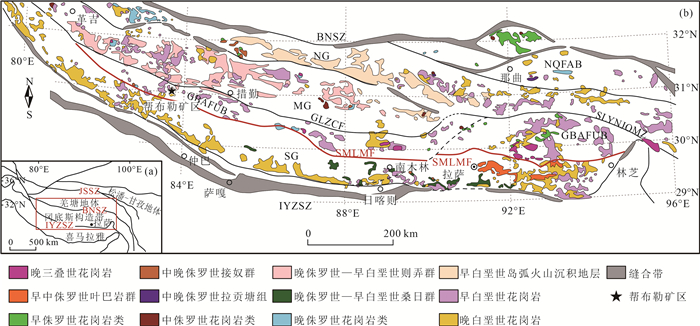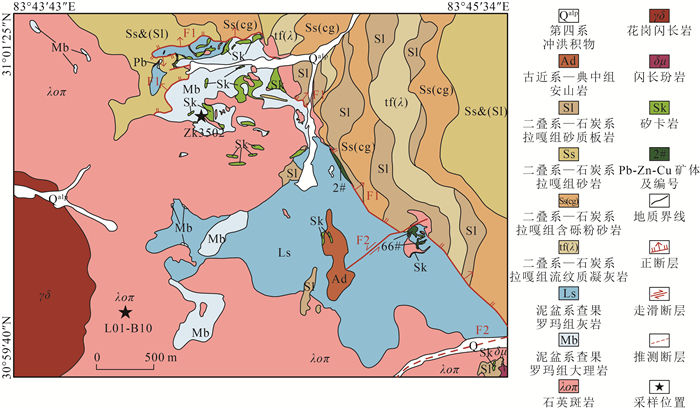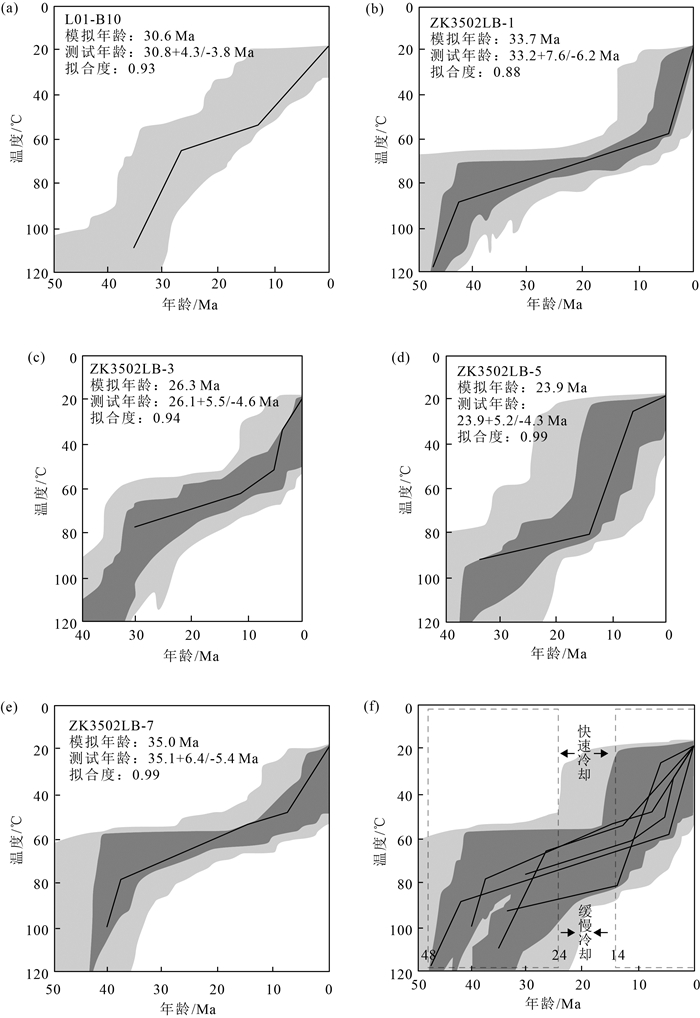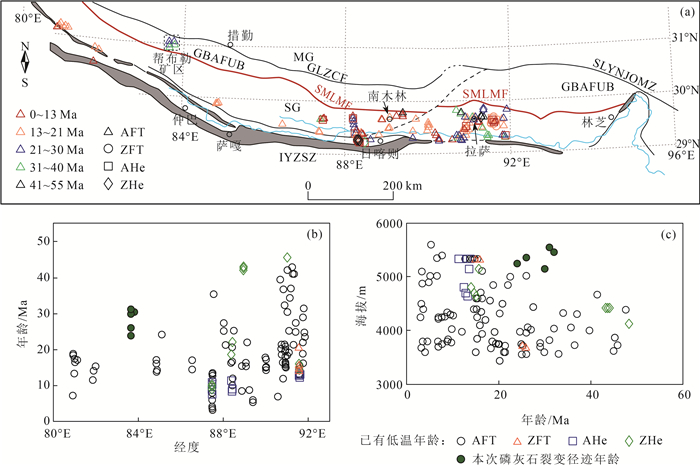Exhumation and preservation of Bangbule Pb-Zn-Cu deposit in West Gangdese Tectonic Belt: evidence from fission track thermochronology
-
摘要:
帮布勒铅锌铜矿床是近年在冈底斯构造带西段新发现的大型矽卡岩型矿床。采用低温热年代学方法,揭示帮布勒矿区的冷却和剥露历史,评估矿床保存情况,完善冈底斯构造带西段隆升剥露记录。结果显示,石英斑岩磷灰石裂变径迹年龄为24±2~32±3 Ma(1σ),记录了矿区在渐新世时的冷却和剥露时间。热演化历史模拟表明,帮布勒矿区存在3期冷却事件:Ⅰ始新世—渐新世晚期(48~24 Ma),冷却速率为4.56~10.64℃/Ma,与印度-欧亚大陆碰撞及碰撞后的地壳增厚有关;Ⅱ渐新世晚期—中新世中期(24~14 Ma),冷却速率为0.38~1.9℃/Ma,与印度俯冲板块折返、断离有关;Ⅲ中新世中期至今(14 Ma至今),冷却速率为2.28~9.88℃/Ma,与冈底斯构造带发育的南北向裂谷有关;其中5 Ma时,与冈底斯构造带普遍隆升有关。帮布勒矿区自始新世以来的剥露厚度为1.5~2.5 km,典中组火山岩的覆盖为矿床保存至今起到了保护作用。
Abstract:The Bangbule Pb-Zn-Cu deposit is a newly discovered large-scale skarn deposit in the western part of the Gangdese Tectonic Belt in recent years. In this study, the low-temperature thermochronology method was used to reveal the cooling and exhumation history of the Bangbule deposit, evaluate the preservation of the deposit, and improve the uplift and exhumation records of the western Gangdese Tectonic Belt. Apatite fission track age in quartz porphyry is 24±2 ~ 32±3 Ma (1σ), which indicates the rapid cooling and exhumation of Bangbule deposit during the Oligocene. The simulation of thermal evolution history shows that there are three stages of cooling events in the Bangbule deposit. (Ⅰ) From the Eocene to the Late Oligocene (48~24 Ma), the cooling rate was between 4.56℃/Ma and 10.64℃/Ma and the cooling event was related to the tectonic background of India-Eurasia collision and the post-collision crustal thickening; (Ⅱ) From Late Oligocene to Middle Miocene (24~14 Ma), the cooling rate ranges from 0.38℃/Ma to 1.9℃/Ma, which is related to the tectonic background of break-off of the Indian subducted plate.(Ⅲ) From the Middle Miocene to the present (14 Ma to present), the cooling rate is between 2.28℃/Ma and 9.88℃/Ma, which is related to tectonic background of the north-south rift developed in the Gangdese Tectonic Belt.The cooling event was related to the general uplift of the Gangdese Tectonic Belt since 5 Ma ago. The exhumation thickness of the Bangbule deposit since the Eocene is between 1.5~2.5 km. The cover of the volcanic rocks of the Dianzhong Formation has played a protective role in the preservation of the deposit.
-
Key words:
- West Gangdese /
- Bangbule deposit /
- fission track /
- thermal evolution history /
- deposit preservation
-

-
图 1 青藏高原构造分区简图(a)和冈底斯构造带地质单元简图(b)(据Zhu et al., 2011;唐宇等,2022修改)
Figure 1.
图 2 帮布勒矿区地质图(据田坎等,2018修改)
Figure 2.
图 6 冈底斯构造带低温年龄分布图(a) (据Wan et al., 2021修改)、低温年龄-经度关系图(b)和低温年龄-海拔关系图(c)(图中数据来自Pan et al., 1993; Copeland et al., 1995; Yuan et al., 2002; 袁万明等,2001;2002a, b; Gallagher et al., 2003; Zhao et al., 2003; 袁万明等,2007; Li et al., 2016; Zhao et al., 2016; 葛玉魁,2016;Ge et al., 2017; 赵珍等, 2017; Wan et al., 2021)
Figure 6.
表 1 磷灰石裂变径迹分析结果
Table 1. The analytical results of apatite fission track
样品号 海拔/m 颗粒数 ρs/(105·cm-2)
(Ns)ρi /(105·cm-2)
(Ni)ρd/(105·cm-2)
(Nd)P/%
(χ2)中值年龄/Ma(±1σ) 组合年龄/Ma(±1σ) L/μm
(N)L01-B10 5550 42 2.526 (553) 20.177 (4417) 12.630 (5750) 96.2 31±2 31±2 13.0±1.6 (99) ZK3502LB-1 5460 42 0.792 (132) 6.248 (1041) 13.029 (5750) 96.5 32±3 32±3 12.2±1.9 (85) ZK3502LB-3 5360 42 0.879 (157) 8.880 (1587) 13.492 (5750) 100.0 26±3 26±3 12.6±1.9 (55) ZK3502LB-5 5250 42 1.010 (145) 11.482 (1649) 13.840 (5750) 100.0 24±2 24±2 12.7±2.9 (15) ZK3502LB-7 5150 42 1.157 (237) 8.860 (1815) 11.870 (5750) 100.0 30±3 30±3 12.5±1.6 (73) 注:AFT-磷灰石裂变径迹;ρs—自发径迹密度;Ns—自发径迹数目;ρi—诱发径迹密度;Ni—诱发径迹数目;ρd—标准玻璃径迹密度;Nd—标准玻璃径迹数量;误差为1σ;P(χ2)-χ2检验;Zeta =391±17.8;L-平均径迹长度;N-径迹数目 表 2 帮布勒矿区冷却速率与剥露厚度
Table 2. Cooling rate and exhumation of Bangbule deposit
样品号 快速冷却 缓慢冷却 剥露厚度/km 阶段/Ma 速率/mm·a-1 阶段/Ma 速率/mm·a-1 L01-B10 36~28
14~00.15v 0.06 28~14 0.02 2.39 ZK3502LB-01 48~42
5~00.12
0.2042~5 0.02 2.50 ZK3502LB-03 5~3
3~00.26
0.1130~12
12~50.02
0.051.49 ZK3502LB-05 14~7 0.21 34~14
7~00.01
0.021.86 ZK3502LB-07 41~38
8~00.18
0.1038~15
15~80.03
0.022.13 -
[1] Aitchison J C, Davis A M, Badengzhu B, et al. New constraints on the India-Asia collision: the Lower Miocene Gangrinboche conglomerates, Yarlung Tsangpo suture zone, SE Tibet[J]. Journal of Asian Earth Sciences, 2002, 21(3) : 251-263. doi: 10.1016/S1367-9120(02)00037-8
[2] Andrews E R, Billen M I. Rheologic controls on the dynamics of slab detachment[J]. Tectonophysics, 2009, 464(1/4) : 60-69.
[3] Buiter S J H, Govers R, Wortel M J R. Two-dimensional simulations of surface deformation caused by slab detachment[J]. Tectonophysics, 2002, 354(3/4) : 195-210.
[4] Burchart J. Evaluation of uncertainties in fission-track dating: Some statistical and geochemical problems[J]. Nuclear Tracks, 1981, 5(1/2) : 87-92.
[5] Cai F L, Ding L, Yue Y H. Provenance analysis of upper Cretaceous strata in the Tethys Himalaya, southern Tibet: Implications for timing of India-Asia collision[J]. Earth and Planetary Science Letters, 2011, 305: 195-206. doi: 10.1016/j.epsl.2011.02.055
[6] Chu M F, Chung S L, O'Reilly S Y, et al. India's hidden inputs to Tibetan orogeny revealed by Hf isotopes of Transhimalayan zircons and host rocks[J]. Earth and Planetary Science Letters, 2011, 307(3/4) : 479-486.
[7] Chung S L, Chu M F, Zhang Y Q, et al. Tibetan tectonic evolution inferred from spatial and temporal variations in post-collisional magmatism[J]. Earth-Science Reviews, 2005, 68(3/4) : 173-196. http://140.112.114.62/bitstream/246246/172326/1/33.pdf
[8] Chung S L. The nature and timing of crustal thickening in Southern Tibet: Geochemical and zircon Hf isotopic constraints from postcollisional adakites[J]. Tectonophysics, 2009, 483(3/4) : 36-48.
[9] Coleman M, Hodges K. Evidence for Tibetan plateau uplift before 14-Myr ago from a new minimum age for east-west extension[J]. Nature, 1995, 374(6517) : 49-52. doi: 10.1038/374049a0
[10] Copeland P, Harrison T M, Pan Y, et al. Thermal evolution of theGangdese batholith, southern Tibet: A history of episodic unroofing[J]. Tectonics, 1995, 14(2) : 223-236. doi: 10.1029/94TC01676
[11] Dai J G, Wang C S, Hourigan J, et al. Exhumation history of the Gangdese Batholith, Southern Tibetan Plateau: Evidence from apatite and zircon(U-Th) /He thermochronology[J]. Journal of Geology, 2013, 121(2) : 155-172. doi: 10.1086/669250
[12] DeCelles P G, Kapp P, Quade J, et al. Oligocene-Miocene Kailas basin, southwestern Tibet: Record of postcollisional upper-plate extension in the Indus-Yarlung suture zone[J]. Geological Society of American Bulletin, 2011, 123(7/8) : 1337-1362.
[13] Dewey J F, Shackleton R M, Chengfa C, et al. The Tectonic Evolution of the Tibetan Plateau[J]. Philosophical Transactions of the Royal Society A: Mathematical, Physical and Engineering Sciences, 1988, 327(1594) : 379-413.
[14] Ding L, Kapp P, Wan X Q. Paleocene-Eocene record of ophiolite obduction and initial India-Asia collision, south central Tibet[J]. Tectonics, 2005, 24(3) : TC3001.
[15] Ding L, Qasim M, Jadoon I A K, et al. The India-Asia collision in north Pakistan: Insight from the U-Pb detrital zircon provenance of Cenozoic foreland basin[J]. Earth and Planetary Science Letters, 2006, 455: 49-61.
[16] Dupont-Nivet G. Krijgsman W, Langereis C G, et al. Tibetan plateau aridification linked to global cooling at the Eocene-Oligocene transition[J]. Nature, 2007, 445(7128) : 635-638. doi: 10.1038/nature05516
[17] Fitzgerald P G, Sorkhabi R B, Pedfield T F, et al. Uplift and denudation of the central Alaska Range: A case study in the use of apatite fission track thermochronology to determine absolute uplift parameters[J]. Journal of Geophysical Research: Solid Earth, 1995, 100(B10) : 20175-20191. doi: 10.1029/95JB02150
[18] Galbraith R F, Laslett G M. Statistical models for mixed fission track ages[J]. Unclear Tracks and Randiation Measurements, 1993, 21(4) : 459-470. doi: 10.1016/1359-0189(93)90185-C
[19] Gallagher K, Brown R, Johnson C. Fission track analysis and its applications to geological problems[J]. Annual Review of Earth and Planetary Sciences, 2003, 26(1) : 519-572.
[20] Ge Y K, Dai J G, Wang C S, et al. Cenozoic thermo-tectonic evolution of the Gangdese batholith constrained by low-temperature thermochronology[J]. Gondwana Research, 2017, 41: 451-462. doi: 10.1016/j.gr.2016.05.006
[21] Gerya T V, Yuen D A, Maresch W V. Thermomechanical modelling of slab detachment[J]. Earth and Planetary Science Letters, 2004, 226(1/2) : 101-116.
[22] Gleadow A J W, Duddy I R, Green P F, et al. Confined fission track lengths in apatite: a diagnostic tool for thermal history analysis[J]. Contributions to Mineralogy and Petrology, 1986, 94(4) : 405-415. doi: 10.1007/BF00376334
[23] Gogus O H, Pysklywec R N. Mantle lithosphere delamination driving plateau uplift and synconvergent extension in eastern Anatolia[J]. Geology, 2008, 36(9) : 723-726. doi: 10.1130/G24982A.1
[24] Green P F. A new look at statistics in fission-track dating[J]. Nuclear Tracks, 1981, 5(1/2) : 77-86.
[25] Hafkenscheid E, Wortel M J R, Spakman W. Subduction history of the Tethyan region derived from seismic tomography and tectonic reconstructions[J]. Journal of Geophysical Research-Solid Earth, 2006, 111(B8) : 1-2.
[26] Hu X M, Garzanti E, Moore T, et al. Direct stratigraphic dating of India-Asia collision onset at the Selandian(middle Paleocene, 59±1Ma) [J]. Geology, 2015, 43: 859-862.
[27] Jaeger J J, Courtillot V, Tapponnier P. Paleontological view of the ages of the Deccan Traps, the Cretaceous/Tertiary boundary, and the India-Asia collision[J]. Geology, 1989, 17(4) : 316. doi: 10.1130/0091-7613(1989)017<0316:PVOTAO>2.3.CO;2
[28] Kesler S E, Wilkinson B H. The role of exhumation in the temporal distribution of ore deposits[J]. Economic Geology, 2006, 101(5) : 919-922. doi: 10.2113/gsecongeo.101.5.919
[29] Ketcham R A, Donelick R A, Donelick M B. AFT Solve: A program for multi-kinetic modeling of apatite fission-track data[J]. American Mineralogist, 2003, 88(5/6) : 929-929.
[30] Ketcham R A, Carter A, Donelick R A, et al. Improved modeling of fission-track annealing in apatite[J]. American Mineralogist, 2007, 92(5/6) : 799-810.
[31] Ketcham R A, Donelick R A, Balestrieri M L, et al. Reproducibility of apatite fission-track length data and thermal history reconstruction[J]. Earth and Planetary Science Letters, 2009, 284(3/4) : 504-515.
[32] Kind R. Seismic Images of Crust and Upper Mantle Beneath Tibet: Evidence for Eurasian Plate Subduction[J]. Science, 2002, 298(5596) : 1219-1221. doi: 10.1126/science.1078115
[33] Kumar P, Yuan X H, Kind R, et al. Imaging the colliding Indian and Asian lithospheric plates beneath Tibet[J]. Journal of Geophysical Research: Solid Earth, 2006, 111(B6) : B06308.
[34] Laslett G, Green P F, Duddy I R, et al. Thermal annealing of fission tracks in apatite 2. A quantitative analysis[J]. Chemical Geology, 1987, 65(1) : 1-13. doi: 10.1016/0168-9622(87)90057-1
[35] Lee J, Hager C, Wallis S R, et al. Middle to Late Miocene Extremely Rapid Exhumation and Thermal Reequilibration in the Kung Co Rift, Southern Tibet[J]. Tectonics, 2011, 30: 1-26.
[36] Li G W, Kohn B, Sandiford M, et al. Constraining the Age of Liuqu Conglomerate, Southern Tibet: Implications for Evolution of the India-Asia Collision Zone[J]. Earth and Planetary Science Letters, 2015, 426: 259-266. doi: 10.1016/j.epsl.2015.06.010
[37] Li G W, Kohn B, Sandiford M, et al. Synorogenic morphotectonic evolution of the Gangdese batholith, South Tibet: Insights from low-temperature thermochronology[J]. Geochemistry, 2016, 17(1) : 101-102.
[38] Mitsuishi M, Wallis S R, Aoya M, et al. E-W extension at 19 Ma in the Kung Co area, S. Tibet: Evidence for contemporaneous E-W and N-S extension in the Himalayan orogen[J]. Earth and Planetary Science Letters, 2012, 325: 10-20.
[39] Mo X X, Hou Z Q, Niu Y L, et al. Mantle contributions to crustal thickening during continental collision: Evidence from Cenozoic igneous rocks in southern Tibet[J]. Lithos, 2007, 96(1/2) : 225-242.
[40] Pan Y, Copeland P, Roden M K, et al. Thermal and unroofing history of the Lhasa area, Southern Tibet—evidence from apatite fission track thermochronology[J]. Nuclear Tracks & Radiation Measurements, 1993, 21: 543-554.
[41] Replumaz A, Negredo A M, Guillot S, et al. Multiple episodes of continental subduction during India/Asia convergence: Insight from seismic tomography and tectonic reconstruction[J]. Tectonophysics, 2010, 483(1/2) : 125-134.
[42] Replumaz A, Capitanio F A, Guillot S, et al. The coupling of Indian subduction and Asian continental tectonics[J]. Gondwana Research, 2014, 26(2) : 608-626. doi: 10.1016/j.gr.2014.04.003
[43] Rowley D B. Age of initiation of collision between India and Asia: A review of stratigraphic data[J]. Earth and Planetary Science Letters, 1996, 145: 1-13. doi: 10.1016/S0012-821X(96)00201-4
[44] Rowley D B, Currie B S. Palaeo-altimetry of the Late Eocene to Miocene Lunpola basin, central Tibet[J]. Nature, 2006, 439(7077) : 677-681. doi: 10.1038/nature04506
[45] Styron R H, Taylor M H, Sundell K E, et al. Miocene initiation and acceleration of extension in the South Lunggar rift, western Tibet: Evolution of an active detachment system from structural mapping and(U-Th)/He thermochronology[J]. Tectonics, 2013, 32(4) : 880-907.
[46] Tapponnier P, Xu Z Q, Roger F, et al. Geology - Oblique stepwise rise and growth of the Tibet Plateau[J]. Science, 2001, 294(5547) : 1671-1677. doi: 10.1126/science.105978
[47] Teng L S, Lee C T, Tsai Y B, et al. Slab breakoff as a mechanism for flipping of subduction polarity in Taiwan[J]. Geology, 2000, 28(2) : 155-158. doi: 10.1130/0091-7613(2000)28<155:SBAAMF>2.0.CO;2
[48] Wagner G A, Reimer G M. Fission track tectonics: The tectonic interpretation of fission track apatite ages[J]. Earth and Planetary Science Letters, 1972, 14(2) : 263-268. doi: 10.1016/0012-821X(72)90018-0
[49] Wan X Q, Sun X. Apatite fission track thermochronology of Cenozoic igneous rocks from porphyry copper deposits in the Gangdese belt of southern Tibet: Implications for cooling history and ore preservation[J]. Ore Geology Reviews, 2021, 133: 1-10.
[50] Wang Y, Zhang X, Sun L, et al. Cooling history and tectonic exhumation stages of the south-central Tibetan Plateau(China) : constrained by 40Ar/39Ar and apatite fission trackthermochronology[J]. Journal of Asian Earth Sciences, 2007, 29(2/3) : 266~282.
[51] Williams H, Turner S, Kelley S, et al. Age and composition of dikes in Southern Tibet: New constraints on the timing of east-west extension and its relationship to postcollisional volcanism[J]. Geology, 2001, 29(4) : 188-193.
[52] Wortel M J R, Spakman W. Subduction and slab detachment in the Mediterranean-Carpathian region[J]. Science, 2001, 290(5498) : 437-437.
[53] Wu F Y, Ji W Q, Wang J G, et al. Zircon U-Pb and Hf isotopic constraints on the onset time of India-Asia collision[J]. American Journal of Science, 2014, 314(2) : 548-579. doi: 10.2475/02.2014.04
[54] Yin A, Harrison T M, Ryerson F J, et al. Tertiary Structural Evolution of the Gangdese Thrust System, Southeastern Tibet[J]. Journal of Geophysical Research-Solid Earth, 1994, 99(B9) : 18175-18201. doi: 10.1029/94JB00504
[55] Yin A, Harrison T M. Geologic Evolution of the Himalayan-Tibetan Orogen[J]. Annual Review of Earth and Planetary Sciences, 2000, 28: 211-280. doi: 10.1146/annurev.earth.28.1.211
[56] Yuan W M, Wang S C, Li S R, et al. Apatite fission track dating evidence on thetectonization of Gangdese block, south Qinghai-Tibetan Plateau[J]. Chinese Science Bulletin, 2002, 47(3) : 239-243. doi: 10.1360/02tb9057
[57] Zhao Z D, Mo X X, Guo T Y, et al. Fission track age of granite batholith from Southern Tibet: implications for the plateau uplift[J]. Progress In Natural Science-Materials International, 2003, 13(8) : 632-636.
[58] Zhao J X, Qin K Z, Xiao B, et al. Thermal history of the giant Qulong Cu-Mo deposit, Gangdese metallogenic belt, Tibet: Constraints on magmatic-hydrothermal evolution and exhumation[J]. Gondwana Research, 2016, 36: 390-409. doi: 10.1016/j.gr.2015.07.005
[59] Zhu D C, Zhao Z D, Niu Y L, et al. The Lhasa Terrane: Record of a microcontinent and its histories of drift and growth[J]. Earth and Planetary Science Letters, 2011, 301(1/2) : 241-255.
[60] 曹凯. 帕米尔东北缘新生代构造过程的裂变径迹热年代学和构造地貌研究[D]. 中国地质大学博士学位论文, 2011.
[61] 董彦辉, 许继峰, 曾庆高, 等. 存在比桑日群弧火山岩更早的新特提斯洋俯冲记录么?[J]. 岩石学报, 2006, 22(3) : 661-668. https://www.cnki.com.cn/Article/CJFDTOTAL-YSXB200603015.htm
[62] 杜德道, 曲晓明, 王根厚, 等. 西藏班公湖-怒江缝合带西段中特提斯洋盆的双向俯冲: 来自岛弧型花岗岩锆石U-Pb年龄和元素地球化学的证据[J]. 岩石学报, 2011, 27(7) : 1993-2002. https://www.cnki.com.cn/Article/CJFDTOTAL-YSXB201107009.htm
[63] 高顺宝, 郑有业, 王进寿, 等. 西藏班戈地区侵入岩年代学和地球化学: 对班公湖-怒江洋盆演化时限的制约[J]. 岩石学报, 2011, 27(7) : 1973-1982. https://www.cnki.com.cn/Article/CJFDTOTAL-YSXB201107007.htm
[64] 高顺宝. 西藏冈底斯西段铜铁多金属成矿作用与找矿方向[D]. 中国地质大学博士学位论文, 2015.
[65] 葛玉魁. 冈底斯造山带新生代以来剥露历史的热年代学约束及沉积响应[D]. 中国地质大学(北京) 博士学位论文, 2016.
[66] 耿全如, 潘桂棠, 王立全, 等. 班公湖-怒江带、羌塘地块特提斯演化与成矿地质背景[J]. 地质通报, 2011, 30(8) : 1261-1274. doi: 10.3969/j.issn.1671-2552.2011.08.013
[67] 和钟铧, 杨德明, 郑常青, 等. 西藏冈底斯带门巴地区印支期花岗岩地球化学特征及其构造意义[J]. 地质通报, 2005, 24(4) : 354-359. doi: 10.3969/j.issn.1671-2552.2005.04.009
[68] 侯增谦, 曲晓明, 杨竹森, 等. 青藏高原碰撞造山带: Ⅲ. 后碰撞伸展成矿作用[J]. 矿床地质, 2006a, 25(6) : 629-651. https://www.cnki.com.cn/Article/CJFDTOTAL-KCDZ200606000.htm
[69] 侯增谦, 赵志丹, 高永丰, 等. 印度大陆板片前缘撕裂与分段俯冲: 来自冈底斯新生代火山-岩浆作用证据[J]. 岩石学报, 2006b, 22(4) : 761-774. https://www.cnki.com.cn/Article/CJFDTOTAL-YSXB200604001.htm
[70] 胡修棉, 王建刚, 安慰, 等. 利用沉积记录精确约束印度-亚洲大陆碰撞时间与过程[J]. 中国科学: 地球科学, 2017, 47(3) : 261-283. https://www.cnki.com.cn/Article/CJFDTOTAL-JDXK201703001.htm
[71] 黄鹏程, 郑有业, 高顺宝, 等. 西藏帮布勒铅锌铜铁矿床地球化学特征及找矿意义[J]. 矿物学报, 2015, 35(S1) : 394. https://www.cnki.com.cn/Article/CJFDTOTAL-KWXB2015S1284.htm
[72] 贾建称, 温长顺, 王根厚, 等. 冈底斯地区林子宗群火山岩岩石地球化学特征及地球动力学意义[J]. 中国地质, 2005, 32(3) : 396-404. https://www.cnki.com.cn/Article/CJFDTOTAL-DIZI200503007.htm
[73] 康志强, 许继峰, 王保弟, 等. 拉萨地块北部白垩纪多尼组火山岩的地球化学: 形成的构造环境[J]. 地球科学(中国地质大学学报), 2009, 34(1) : 89-104. https://www.cnki.com.cn/Article/CJFDTOTAL-DQKX200901010.htm
[74] 康志强, 许继峰, 王保弟, 等. 拉萨地块北部去申拉组火山岩: 班公湖-怒江特提斯洋南向俯冲的产物?[J]. 岩石学报, 2010, 26(10) : 3106-3116. https://www.cnki.com.cn/Article/CJFDTOTAL-YSXB201010022.htm
[75] 李光明, 李金祥, 秦克章, 等. 西藏班公湖带多不杂超大型富金斑岩铜矿的高温高盐高氧化成矿流体: 流体包裹体证据[J]. 岩石学报, 2007, 23(5) : 935-952. https://www.cnki.com.cn/Article/CJFDTOTAL-YSXB200705009.htm
[76] 李金祥, 李光明, 秦克章, 等. 班公湖带多不杂富金斑岩铜矿床斑岩-火山岩的地球化学特征与时代: 对成矿构造背景的制约[J]. 岩石学报, 2008, 24(3) : 531-543. https://www.cnki.com.cn/Article/CJFDTOTAL-YSXB200803013.htm
[77] 刘增乾, 徐宪, 潘桂棠, 等. 青藏高原大地构造与形成演化[M]. 北京: 地质出版社, 1990: 1-174.
[78] 孟元库, 许志琴, 马士委, 等. 藏南冈底斯岩浆带中段曲水韧性剪切带的变形特征及其年代学约束[J]. 地球科学—中国地质大学学报, 2016, 41(7) : 1081-1098. https://www.cnki.com.cn/Article/CJFDTOTAL-DQKX201607001.htm
[79] 潘桂棠, 莫宣学, 侯增谦, 等. 冈底斯造山带的时空结构及演化[J]. 岩石学报, 2006, 22(3) : 521-533. https://www.cnki.com.cn/Article/CJFDTOTAL-YSXB200603001.htm
[80] 曲晓明, 辛洪波, 赵元艺, 等. 西藏班公湖中特提斯洋盆的打开时间: 镁铁质蛇绿岩地球化学与锆石U-Pb LA-ICP-MS定年结果[J]. 地学前缘, 2010, 17(3) : 53-63. https://www.cnki.com.cn/Article/CJFDTOTAL-DXQY201003007.htm
[81] 曲晓明, 辛洪波, 杜德道, 等. 西藏班公湖-怒江缝合带中段碰撞后A型花岗岩的时代及其对洋盆闭合时间的约束[J]. 地球化学, 2012, 41(1) : 1-14. https://www.cnki.com.cn/Article/CJFDTOTAL-DQHX201201002.htm
[82] 曲晓明, 辛洪波, 杜德道, 等. 西藏班公湖-怒江缝合带中段A-型花岗岩的岩浆源区与板片断离[J]. 地质学报, 2013, 87(6) : 759-772. https://www.cnki.com.cn/Article/CJFDTOTAL-DZXE201306002.htm
[83] 宋青杰. 冈底斯朱诺斑岩型铜矿床隆升剥露与变化保存[D]. 中国地质大学(北京) 硕士学位论文, 2018.
[84] 唐宇, 王根厚, 冯翼鹏, 等. 西藏南冈底斯叶巴火山弧的构造-地层属性及其演化[J]. 地学前缘, 2022, 29(1) : 285-302. https://www.cnki.com.cn/Article/CJFDTOTAL-DXQY202201019.htm
[85] 田坎, 郑有业, 高顺宝, 等. 西藏帮布勒矽卡岩型Pb-Zn-Cu-Fe矿床流体来源及演化: 来自流体包裹体及稳定同位素的制约[J]. 大地构造与成矿学, 2018, 42(6) : 1027-1045. https://www.cnki.com.cn/Article/CJFDTOTAL-DGYK201806008.htm
[86] 田坎, 郑有业, 高顺宝, 等. 西藏冈底斯西段帮布勒Pb-Zn-Cu矿床晚白垩世岩浆岩成因及意义[J]. 地球科学, 2019, 44(6) : 1905-1922. https://www.cnki.com.cn/Article/CJFDTOTAL-DQKX201906012.htm
[87] 田坎. 西藏帮布勒铅锌铜铁矿床地质地球化学特征及成因研究[D]. 中国地质大学博士学位论文, 2019.
[88] 王国灿, 曹凯, 张克信, 等. 青藏高原新生代构造隆升阶段的时空格局[J]. 中国科学: 地球科学, 2011, 41(3) : 332-349. https://www.cnki.com.cn/Article/CJFDTOTAL-JDXK201103006.htm
[89] 王珂, 袁万明, 冯星, 等. 东昆仑埃坑地区磷灰石裂变径迹年代学及构造意义[J]. 原子能科学技术, 2018, 52(1) : 186-192. https://www.cnki.com.cn/Article/CJFDTOTAL-YZJS201801030.htm
[90] 王振武, 吴运军, 高顺宝, 等. 综合物探在西藏仲巴县帮布勒地区找矿中的应用和意义[J]. 地质科技情报, 2018, 37(6) : 202-210. https://www.cnki.com.cn/Article/CJFDTOTAL-DZKQ201806025.htm
[91] 肖文交, 敖松坚, 杨磊, 等. 喜马拉雅汇聚带结构-属性解剖及印度-欧亚大陆最终拼贴格局[J]. 中国科学: 地球科学, 2017, 47(6) : 631-656. https://www.cnki.com.cn/Article/CJFDTOTAL-JDXK201706001.htm
[92] 肖序常, 李廷栋, 李光岑. 喜马拉雅岩石圈构造演化[M]. 北京: 地质出版社, 1988: 201-210.
[93] 许志琴, 赵中宝, 马绪宣, 等. 从安第斯到冈底斯: 从洋-陆俯冲到陆-陆碰撞[J]. 地质学报, 2019, 93(1) : 1-11. https://www.cnki.com.cn/Article/CJFDTOTAL-DZXE201901002.htm
[94] 姚晓峰, 唐菊兴, 李志军, 等. 班公湖-怒江带西段尕尔穷矽卡岩型铜金矿含矿母岩成岩时代的重新厘定及其地质意义[J]. 地质论评, 2013, 59(1) : 193-200. https://www.cnki.com.cn/Article/CJFDTOTAL-DZLP201301027.htm
[95] 袁万明, 王世成, 李胜荣, 等. 西藏冈底斯带构造活动的裂变径迹证据[J]. 科学通报, 2001, 46(20) : 1739-1742. https://www.cnki.com.cn/Article/CJFDTOTAL-KXTB200120016.htm
[96] 袁万明, 王世成, 李胜荣, 等. 拉萨地块南缘热液金铜矿床成矿时代的裂变径迹研究[J]. 自然科学进展, 2002a, 12(5) : 95-98. https://www.cnki.com.cn/Article/CJFDTOTAL-ZKJZ200205026.htm
[97] 袁万明, 王世成, 杨志强, 等. 北喜马拉雅带构造活动的裂变径迹定年证据[J]. 核技术, 2002b, 25(6) : 451-454. https://www.cnki.com.cn/Article/CJFDTOTAL-HJSU200206009.htm
[98] 袁万明, 杜杨松, 杨立强, 等. 西藏冈底斯带南木林地区构造活动的磷灰石裂变径迹分析[J]. 岩石学报, 2007, 23(11) : 2911-2917. https://www.cnki.com.cn/Article/CJFDTOTAL-YSXB200711022.htm
[99] 袁万明. 矿床保存变化研究的热年代学技术方法[J]. 岩石学报, 2016, 32(8) : 2571-2578. https://www.cnki.com.cn/Article/CJFDTOTAL-YSXB201608023.htm
[100] 翟裕生. 成矿系统研究与找矿[J]. 地质调查与研究, 2003, 26(2) : 65-71. https://www.cnki.com.cn/Article/CJFDTOTAL-QHWJ200302000.htm
[101] 张进江, 丁林, 钟大赉, 等. 喜玛拉雅平行于造山带伸展——是垮塌的标志还是挤压隆升过程的产物?[J]. 科学通报, 1999, 44(19) : 2031-2036. https://www.cnki.com.cn/Article/CJFDTOTAL-KXTB199919003.htm
[102] 张进江. 北喜马拉雅及藏南伸展构造综述[J]. 地质通报, 2007, 26(6) : 639-649. http://dzhtb.cgs.cn/gbc/ch/reader/view_abstract.aspx?file_no=200706111&flag=1
[103] 张亮亮. 西藏中拉萨地块申扎岩浆岩的年代学和地球化学[D]. 中国地质大学(北京) 博士学位论文, 2011.
[104] 张运昌, 陈彦, 杨青, 等. 西藏冈底斯带中部南木林地区林子宗群火山岩锆石U-Pb年龄和地球化学特征[J]. 地质通报, 2019, 38(5) : 719-732. http://dzhtb.cgs.cn/gbc/ch/reader/view_abstract.aspx?file_no=20190503&flag=1
[105] 张志, 唐菊兴, 陈毓川, 等. 西藏班-怒结合带尕尔穷铜金矿床矽卡岩矿物学特征及其地质意义[J]. 岩石矿物学杂志, 2013a, 32(3) : 305-317. https://www.cnki.com.cn/Article/CJFDTOTAL-YSKW201303004.htm
[106] 张志, 唐菊兴, 姚晓峰, 等. 西藏尕尔穷-嘎拉勒铜金矿集区中侏罗世晚期岛弧闪长岩的厘定及其构造意义[J]. 矿物学报, 2013b, 33(A2) : 872-873. https://www.cnki.com.cn/Article/CJFDTOTAL-KWXB2013S2485.htm
[107] 赵元艺, 崔玉斌, 吕立娜, 等. 西藏舍索矽卡岩型铜多金属矿床年代学与地球化学特征及意义[J]. 岩石学报, 2011, 27(7) : 2132-2142. https://www.cnki.com.cn/Article/CJFDTOTAL-YSXB201107021.htm
[108] 赵珍, 陆露, 吴珍汉, 等. 西藏冈底斯新生代以来的抬升过程——磷灰石裂变径迹热史模拟的证据[J]. 地质通报, 2017, 36(9) : 1553-1561. http://dzhtb.cgs.cn/gbc/ch/reader/view_abstract.aspx?file_no=20170907&flag=1
[109] 郑有业, 次琼, 高顺宝, 等. 西藏冈底斯西段银锡铜多金属成矿系列与找矿方向[J]. 地学前缘, 2021, 28(3) : 379-402. https://www.cnki.com.cn/Article/CJFDTOTAL-DXQY202103033.htm
[110] 周详, 曹佑功. 西藏板块构造-建造图及说明书[M]. 北京: 地质出版社, 1984: 1-20.
[111] 周祖翼. 低温年代学: 原理与应用[M]. 北京: 科学出版社, 2014.
-




 下载:
下载:





